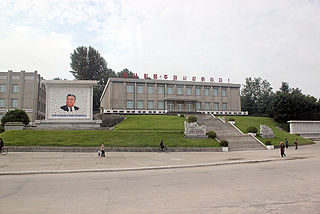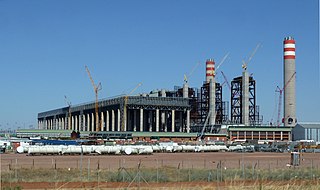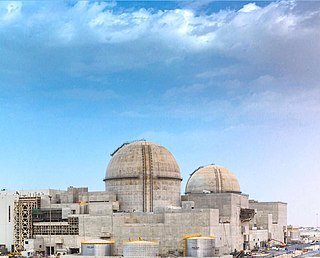| Samcheonpo Power Plant | |
|---|---|
 | |
| Country | |
| Coordinates | 34°54′42″N128°06′35″E / 34.9118°N 128.1096°E |
| Operator(s) |
|
| Power generation | |
| Nameplate capacity |
|
Samcheonpo Power Station is a large coal-fired power station in South Korea. [1] [2] [3]
| Samcheonpo Power Plant | |
|---|---|
 | |
| Country | |
| Coordinates | 34°54′42″N128°06′35″E / 34.9118°N 128.1096°E |
| Operator(s) |
|
| Power generation | |
| Nameplate capacity |
|
Samcheonpo Power Station is a large coal-fired power station in South Korea. [1] [2] [3]

Naju is a city in South Jeolla Province, South Korea.
Korea Hydro & Nuclear Power is a subsidiary of the Korea Electric Power Corporation (KEPCO). It operates large nuclear and hydroelectric plants in South Korea, which are responsible for about 27 percent of the country's electric power.

Kŭmya County is a county in South Hamgyŏng province, North Korea. It borders the Sea of Japan to the east.
Korea Electric Power Corporation, better known as KEPCO (Korean: 켑코) or Hanjeon (Korean: 한전), is the largest electric utility in South Korea, responsible for the generation, transmission and distribution of electricity and the development of electric power projects including those in nuclear power, wind power and coal. KEPCO, through its subsidiaries, is responsible for 93% of Korea's electricity generation as of 2011. The South Korean government owns a 51.11% share of KEPCO. Together with its affiliates and subsidiaries, KEPCO has an installed capacity of 65,383 MW. On the 2011 Fortune Global 500 ranking of the world's largest companies, KEPCO was ranked 271. KEPCO is a member of the World Energy Council, the World Nuclear Association and the World Association of Nuclear Operators. As of August 2011, KEPCO possesses an A+ credit rating with Fitch Ratings, while Moody's has assigned KEPCO an A1 stable rating.

South Korea is a major energy importer, importing nearly all of its oil needs and ranking as the second-largest importer of liquefied natural gas in the world. Electricity generation in the country mainly comes from conventional thermal power, which accounts for more than two thirds of production, and from nuclear power.

Medupi Power Station is a dry-cooled coal-fired power station built by Eskom near Lephalale in Limpopo province, South Africa. The station consists of 6 generating units with a nameplate capacity of 800 MW each bringing the total installed capacity of 4,800 MW.

The United Arab Emirates is installing nuclear-powered plants to meet their electricity demand, which is estimated to increase from 15 GWe to over 40 GWe in 2020. In December 2009, the US and UAE signed a Section 123 Agreement for peaceful nuclear cooperation. The UAE has also signed Nuclear Non-Proliferation Treaty (NPT), along with the additional protocol.
KEPCO E&C is a power plant design and engineering company in South Korea. It was established in 1975 as a public enterprise. KEPCO E&C engages in designing, engineering, and constructing nuclear and fossil power plants. The company operates as a subsidiary of Korea Electric Power Corporation (KEPCO).

Pakistan–South Korea relations refers to bilateral diplomatic relationship between Pakistan and South Korea. Since the 1980s, the relations between the two Asian states have improved and periodically enhanced. Pakistan has an embassy in Seoul, South Korea, and South Korea has an embassy in Islamabad, Pakistan. Pakistan is one of the few countries that has good relations with both North Korea and South Korea.
NuGeneration (NuGen) was a company that planned to build a new nuclear power station nearby the Sellafield nuclear site in the United Kingdom. The proposed site was called Moorside, and is to the north and west of Sellafield. On 8 November 2018, Toshiba announced their withdrawal from the project and intent to liquidate NuGen.

The Alamosa Solar Generating Plant is a 35.3 MWp (30.0 MWAC) concentrator photovoltaics (CPV) power station, the largest in the world when it was completed, in May 2012. It is currently the world's third largest operating CPV facility. The output is being sold to Public Service of Colorado, a subsidiary of Xcel Energy, under a long term Power Purchase Agreement.

The APR-1400 is an advanced pressurized water nuclear reactor designed by the Korea Electric Power Corporation (KEPCO). Originally known as the Korean Next Generation Reactor (KNGR), this Generation III reactor was developed from the earlier OPR-1000 design and also incorporates features from the US Combustion Engineering (C-E) System 80+ design. Currently in South Korea there are 3 units in operation, and 3 units in construction. Three units are completed and in commercial operation in the United Arab Emirates at Barakah, with one more under construction at the same plant.
Moorside nuclear power station is proposed for a site near Sellafield, in Cumbria, England. The original plan by NuGeneration, a British subsidiary of Toshiba-owned Westinghouse Electric Company, had the station coming online from 2024 with 3.4 GW of new nuclear capacity, from three AP1000 reactors. Work up to 2018 would include acquiring the site licence, the development consent order, and other required permits and permissions to start work. Site preparation was to take two years, up to 2020.
Korea Power Exchange (한국전력거래소), also known as KPX, is the quasi-governmental agency under the Ministry of Trade, Industry and Energy responsible for operating the electricity market and the electric power system in South Korea. In order to ensure fair and transparent operation of the market, as well as stable and efficient operation of the grid, it was established in April 2001 by being spun off from the Korea Electric Power Corporation (KEPCO) as a part of the industry restructuring efforts. Because the legal name (한국전력거래소) may give a false impression that it is a subsidiary of KEPCO (한국전력공사), the general name of 전력거래소 is used for most purposes.
Yonghungdo Power Station is a large coal-fired power station on Yonghungdo Island near Inchon, South Korea, owned by Korea Electric Power Corporation. The plant is estimated to have been the coal-fired power plant which emitted the ninth most carbon dioxide in 2018, at 27 million tons, and relative emissions are estimated at 1.5 kg per kWh. Conversion to gas is being considered.
Choi Seong-deok is a South Korean rugby union player. He plays club rugby for KEPCO in the Korea Super Rugby League, he has represented Korea internationally at both sevens and XVs.
Boryeong Power Station is a large coal-fired power station in South Korea.
Hadong Power Station is a large coal-fired power station in South Korea.